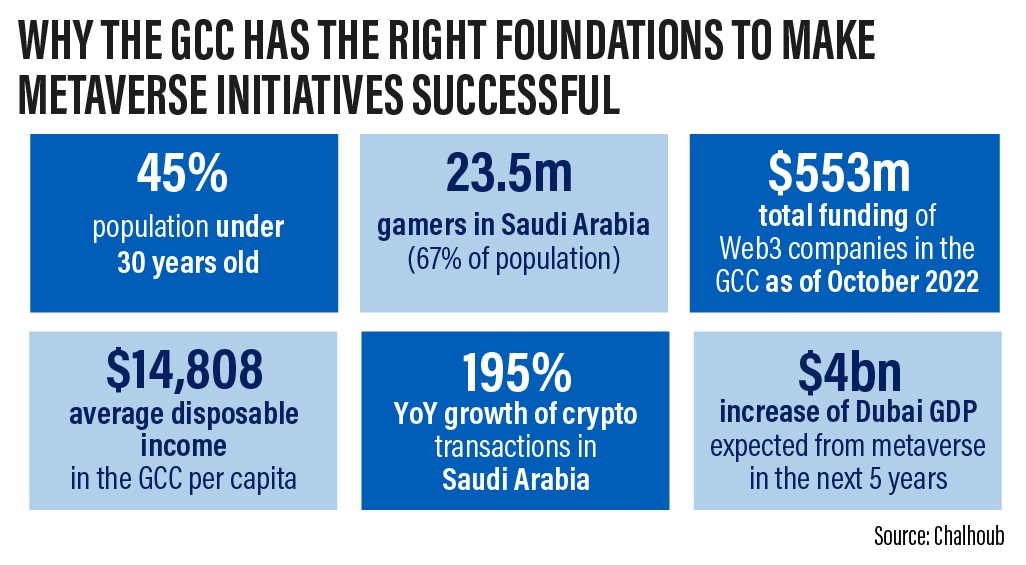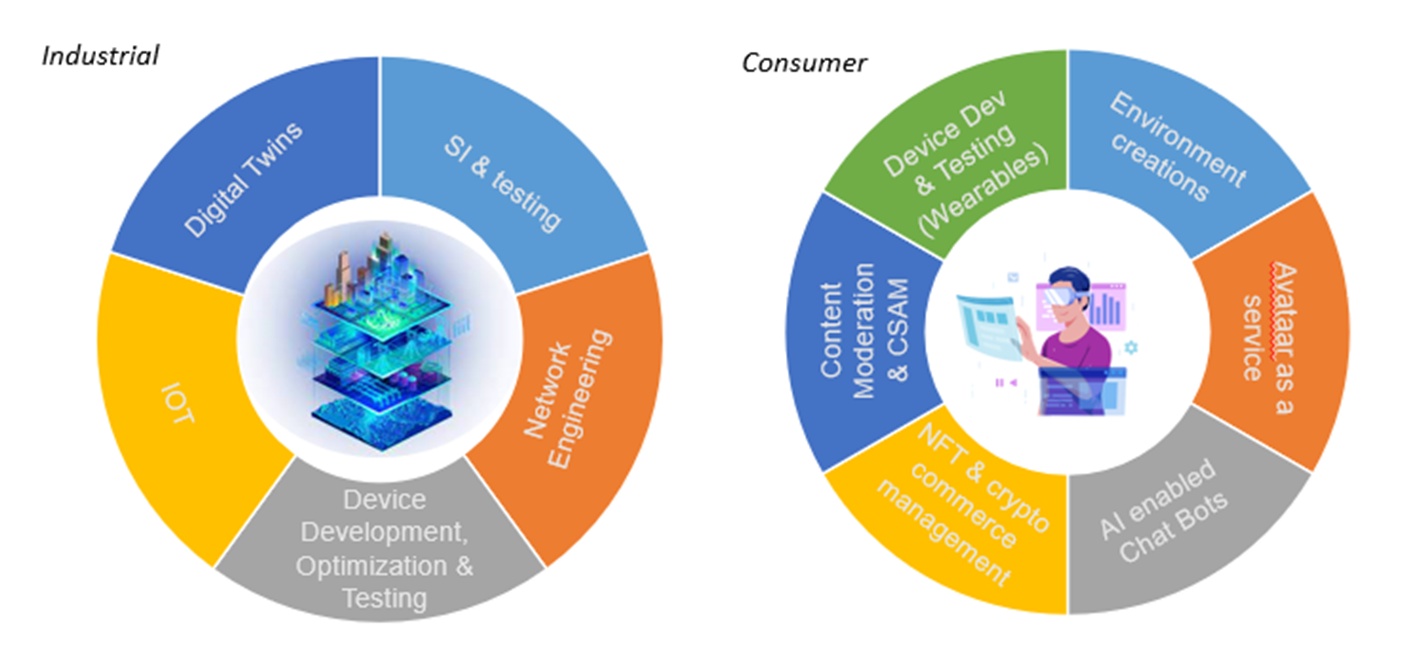Industry Thought Leadership
Metaverse and Applicability in the Telecom Industry
January, 2023Into the Middle East – Viewpoint on Emerging technologies
The technology landscape in the Middle East is constantly changing, and as a region that adopts technology the fastest, it is poised to become a prominent player in the Metaverse. Metaverse has the potential to transform the key sectors in the region, such as telecom, travel and tourism, financial services, and real estate.
The Dubai Metaverse Strategy, which was launched in July 2022 with the goal of making Dubai one of the top Metaverse economies, has also helped speed up adoption in the region. It is designed to add $4 billion to the economy in the next five years. Saudi Arabia's $500 billion investment in developing NEOM as the world's first cognitive city will also provide a significant boost to the adoption of Metaverse and Digital Twins.
The GCC (Gulf Cooperation Council), the well-known alliance between six Middle East countries, has also shown great potential for Metaverse adoption, and Metaverse could contribute about $15 billion to the GCC's economies by 2030 (as per the reports from the ChalHoub group).

Tech Mahindra plays a key role in leading the adoption of metaverse amongst global brands by generating business ROI and drive transformation.
Rise of the "Metaverse": Evolving Consumer Preferences
Technology has to play a key role in driving this transformation. We have come a long way from using static websites to navigating a dynamic website, web portals, and apps built on Web 2.0 infrastructure. However, going forward the biggest shift in the era of telecom evolution will be brought by Metaverse and 5G. 5G will usher us into an era of meta-commerce. Meta-commerce is more immersive, resonates well with digital natives, and leverages Web3 technologies like blockchain and its various applications.
Early industry statistics are promising, indicating that the metaverse and meta commerce have enormous potential. Cart abandonment rates are already increasing in current ecommerce channels. On the other hand, early reports suggest that 70% of customers who have shopped in the metaverse have bought something. The metaverse is here to stay and generate incremental business value for enterprises and individuals alike.
In the last couple of years, there have been significant adoption of augmented and virtual realities (AR/VR) due to increased demand by consumers for a more interactive and richer experiential interface compared to the traditional mails, chatbots and phone-based interactions.
Opportunities in the Metaverse: A Service Provider’s Perspective
There are opportunities galore when it comes to identifying and conceptualizing pan-industry use cases. However, we need to identify a framework that segregates the key use cases and has acceptability and adoption across industries. One way is to look at it from the point of view of the ‘consumer’ (B2B2C and B2C) and ‘enterprise’ (B2B) and identify core and allied services that will enhance business value for the users.
Types of Metaverse Ecosystem & Key Services
Clients are keen to consider and invest in both consumer and industry metaverses. From a consumer metaverse perspective, we are seeing increased adoption for building immersive experiences, near-real virtual trials of products and services, demand generation through AR, VR, and MR exploration of brands and services, gamification of learning, training, and brand engagement & loyalty through non-fungible tokens. From an industrial metaverse perspective, i.e., B2B industries, they are looking at digital twins, modeling virtual assets with data known as performance twins, digital visualization, and prototyping for process improvements and product enhancements.

Telcos play in Metaverse
The introduction of 5G has fueled several significant technological advancements in the telecom sector, one of which is Metaverse. It necessitates unique user equipment as well as widespread, high-bandwidth, low-latency communications that have never been applied to mobile networks in a similar fashion before.
The Metaverse ecosystem is being scaled and made more flexible in large part of businesses, thanks to telcos. Also, metaverse not just addresses the infrastructure requirement for telcos; it also provides economic and strategic benefits for those telcos that actively participate in it.
Essentially, the telcos are vying to enable revenue enhancement and cost optimization to remain profitable. Let us understand how we can equip them to enhance their revenues.
In the 2G era, the telcos used to offer value-added services over the phone to their customers. The 3G and 4G era enabled the telcos to offer web and app-based services such as subscription plans, ads, and other related services. With the onset of the 5G era, operators will be able to offer much more than vanilla bandwidth, piped networks, and network slicing and dicing by offering several other value-added services and bundling cutting-edge applications with bandwidth for their end customers.
This will bring-in additional revenues to telcos. Some of these indicative cross-industry applications may include:
1- Automobiles:
In order to cater to the changing needs of consumers, automotive manufacturers are creating the photorealistic digital twin of their showrooms & dealerships for showcasing their vehicles in the environment. Customers can interact with a real automotive expert, ask questions, explore new features, take a virtual test drive, buy their vehicle, and return to the Meta environments at any time for post-sale support. There are other services as well that can be provided to the customers, like providing a car configurator for customizing the vehicle and ordering those in the metaverse itself.
2- Realty:
The metaverse is altering the real estate industry's dynamics. One of the emerging use cases in the industry is buying/selling properties in the metaverse. Now the property owners can create and showcase their properties in the Metaverse much before their launch to gather responses from people and prospective buyers who may be living internationally and across the country. The metaverse will enable the visits of prospective buyers to get a lively experience where they will be accompanied by the AI concierge and customer agents who will help them with all the queries they have regarding the property.
3- Next Gen Meeting:
The way we work has changed ever since the onset of COVID, and we can see a lot of the workforce working remotely on different projects, which has led to communication gaps between the people. Meta-rooms, as opposed to traditional team meetings, can solve communication and interaction issues by bridging the gap between physical and virtual meetings. This is where Next Gen meeting platforms come into play; we are seeing an increase in requests for such environments and are already working with many customers on their development.
4- Retail Enablement Stores:
Telcos and retailers are investing heavily in customer service centers to achieve the highest level of customer satisfaction, resulting in a high capital infusion and lower profits. We can augment these physical centers with virtual product stores, which can help them optimize resource productivity in physical stores and enhance the returns on investment. The potential benefits of the solution include reduced capital infusion, increased resource utilization, better returns on investment, and an enhanced & immersive customer experience.
Futuristic Use Cases Driving Innovation
The other aspect which is of prime concern for telcos is optimizing their spends. Some of the key use cases that can help drive this include:
1 - Drive Testing of Telecom Devices:
Network operators need to test devices across multiple locations before launch. The impact of device-level parameters is variable and requires manual testing. This is where Metaverse comes into play, it helps in avoiding the need to do manual drive testing by creating a digital twin of the environment and using synthetic data to compare with the actual data in the Metaverse ecosystem. The major benefits delivered by the solution include reduced manual testing efforts leading to time and cost saving andprecise analysis based on the availability of real-time data, thereby enhancing the operational efficiency of the process.
2 - Digital Twin for Network Beam Formation
Most of the telecom operators, on their part, are challenged by limited available information on the interaction between radio transmitters, the environment, and humans and devices that are on the move which in turn results in a high rate of customers churn / porting from one operator to anther due to poor signal strength and network connectivity with incumbent telcos. A solution to run real-time simulations on city scale DT’s using RF propagation & RTX ray tracing to accurately visualize and analyse real-time signal quality. This also incorporates non-geometric data via LIDAR sensors to create photorealistic accurate 3D model of the city. Potential benefits of the solution include a faster development cycle due to real-time testing of products, better network optimization by simulating various scenarios, swifter networks resulting in faster processing and insights and VR-enabled visualization of a city model at 1:1 scale.
3 - Edge Computing with 5G:
With decentralization as the core theme of metaverse applications, the need to move computing power towards the nodes and spokes away from the hub and into the hands of the user becomes paramount. For mission-critical, high-throughput, low-latency industrial applications on remote devices, real-time computing is a challenge. With fewer IoT devices, computation can still be managed by traditional data center infrastructures, but as we scale up and have multiple points of physical data being recorded, the focus has to shift to the logical edge of the infrastructure. Using the MEC server deployment (+nodes, routers, and gateways), telcos can reduce bandwidth and latency budgets by moving the computing from a remote cloud server to a node closer to the consumption source. As service providers at the forefront of this innovative technology, we need to synergize and adopt a collaborative solutioning approach that focuses on sharing best practices and solving a client’s business problem rather than force-fitting the technology. The collaborative approach should lead to formulation of a design-thinking roadmap for the enterprise customer that is aligned with their digital strategy. The technology, its benefits, and applicable use cases need to be identified and their potential impact on the business parameters assessed. Our approach and solution help bring in several enhancements including performance monitoring and predictive analysis in the digital twins we create for our customers.

